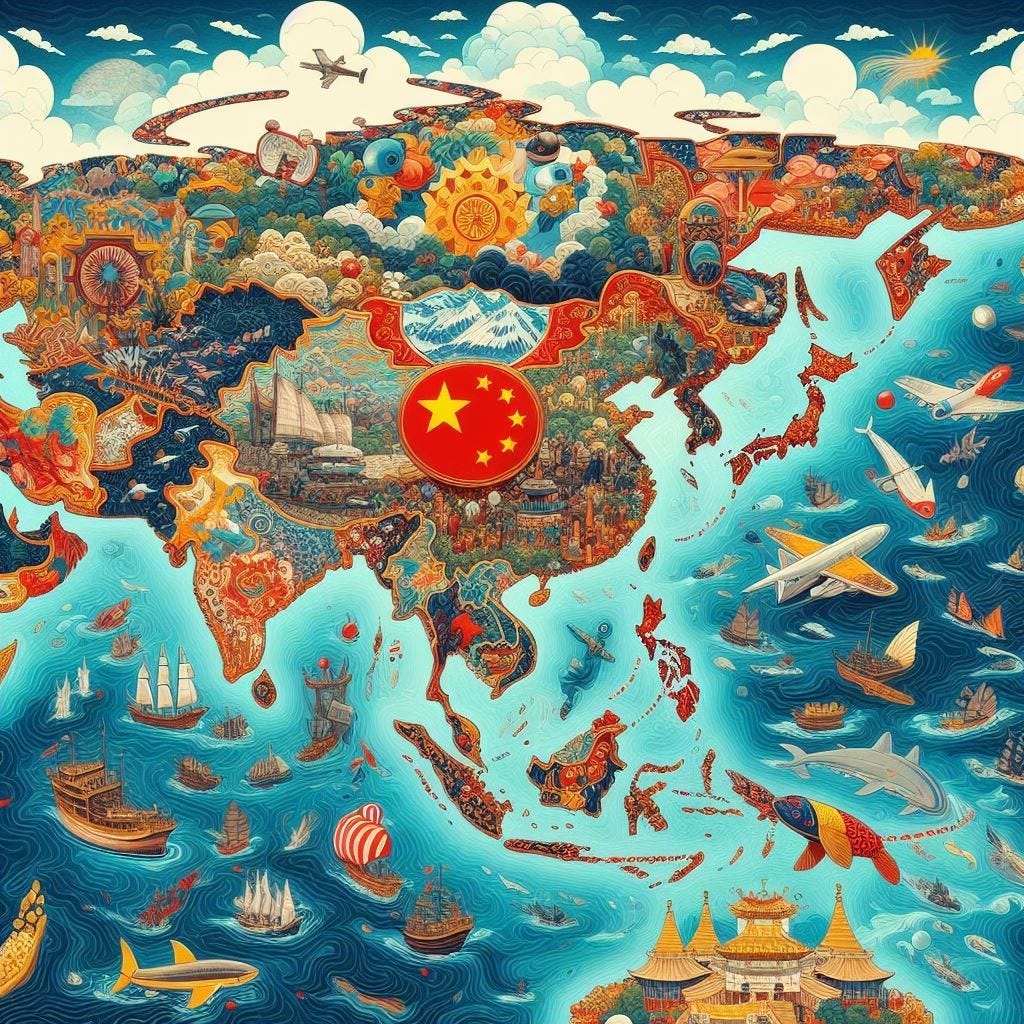as reprint from the publication
Shi Yuanhua (石源华) – 2 November 2023
Shanghai Institute for International Strategic Studies (上海国际战略问题研究会)
PREAMBLE
In a presentation on 2 November 2023, veteran international relations expert Shi Yuanhua (石源华) describes what he sees as being some of the core elements of “China's strategy towards its periphery” (中国周边战略): stabilising relations with the US; deepening regional economic integration; expanding China’s maritime presence to the Sea of Japan up to the Arctic Ocean; shoring up its northern and western periphery; and creating a “community of common destiny” in direct opposition to the “hegemonic” and “values-driven” model currently offered by the US. In short, this is a strategy to foster a new China-led regional order.
The term “periphery” (周边) could also be translated here as China’s “extended neighbourhood” or something along those lines. Although some Chinese scholars may employ it to refer to countries that share a land or maritime border with China, Shi uses it here in its broadest sense and includes an area ranging from the Middle East and Djibouti to the Arctic Ocean and Australia.
The author Shi Yuanhua expressed "It would be America's greatest misfortune if it were to turn China ... from an imaginary enemy into its own gravedigger."
I. “The Russo-Ukrainian War and the Security of China's Periphery”
“The outbreak of the Russo-Ukrainian War has had a significant impact on the great changes [not seen] in a century and on the US's new global strategy. It has led to turmoil in the Taiwan Strait, to US-DPRK [tensions] on the Korean peninsula, to the escalation of Israeli-Palestinian conflict and so on and so forth. This has resulted in an era where danger lurks on every side [危机四伏] of China's periphery.”
“The war between Russia and Ukraine means that the focus of the US’s global strategy has remained on Europe. As long as the flames of the Russo-Ukrainian war continue to burn and [as long as] the US and its Western allies do not stop ‘adding fuel to the fire’ [拱火], the focus of the US's strategy is unlikely to shift eastward [难以东移].”
“China's policy of urging peace talks in response to the Russo-Ukrainian war has created a new framework and new features in this conflict. It has prevented the emergence of a bipolar bloc confrontation between China and the United States and a ‘new cold war’ from taking place.”
“The Russo-Ukrainian war has had a double impact on China's periphery diplomacy. To a certain extent, it has been similar to 9/11 in drawing the focus of the US and its allies’ attention toward [a particular region. In this case,] Russia. This is conducive to the widening of China's window of strategic opportunity [战略机遇期] and to the country’s further development and rise.”
II. “The Big Picture of China's Strategy Towards its Periphery: Five Major Features”
1. “China’s overall political strategy in its neighbourhood [diplomacy]: a new framework of confrontation, competition and coexistence between China and the United States.”
“China has determined dispassionately that the United States is the only country that is hindering or that could interrupt its rise, [the only country that] is undermining its national reunification [with Taiwan] and that a strategic contest [战略较量] between China and the US is inevitable. Since 2021, there has even been a certain 'warlike' [临战: lit. on the eve of war] character to this. This is particularly true on the issue of Taiwan, where maintaining our determination to go to war at any moment [今夜就开战: lit. go to war tonight] is essential and where preparedness averts peril [有备无患]. At the same time, we should believe firmly that China has entered its best period of development in the modern era and that time and advantage are on China's side. We must strive to control and [where possible] avoid the expansion and breakdown of the inherent structural contradictions between both sides as well as the emergence of bloc confrontation. We must ‘fight [lit. struggle] but not break’, and avoid the outbreak of a war between China and the United States.”
“China’s overall maritime development strategy in its periphery [diplomacy]: shifting from a ‘one-ocean strategy’ to a ‘two-ocean strategy’ and creating the conditions for the development of a comprehensive peripheral maritime strategy [i.e. a ‘three-ocean strategy’].”
“China's Indo-Pacific strategy predates the US’s. Ten years ago, two of the five routes identified in China's BRI blueprint had the Indian Ocean as their focus. The development of the BRI includes many big projects that are oriented toward the Indian Ocean, such as the China-Pakistan Economic Corridor (CPEC) and the Bangladesh-China-India-Myanmar (BCIM) Economic Corridor. [It includes] port cooperation between China and Pakistan, China and Myanmar and China and Sri Lanka, as well as the Bangladeshi power station etc. [It also includes] naval escorts in the Gulf of Aden and the construction of a naval supply base in Djibouti and so on. China's [strategic] layout in the Indo-Pacific has begun quietly to bear fruit. [Beijing] is gradually establishing a ‘two-ocean strategy’ that encompasses economics, politics, security and culture. It is also creating the conditions for the development of a ‘three-ocean strategy’ [三洋战略]. This refers to the [building of a] ‘Polar Silk Road’, which has the Arctic Ocean as its target, and to the establishment of the Hunchun deep-water port and its opening via the Tumen River estuary to the sea, which [would allow] China to achieve ‘freedom of navigation’ in the Sea of Japan [实现中国对于日本海的’自由航行’]. Only this ‘three-ocean strategy’ may be described as a comprehensive peripheral maritime strategy.”
3. “China’s overall geopolitical and security strategy of its periphery diplomacy: constructing a security barrier [安全屏障] with the northern and western regions as its main focus.”
“At present, China's relations with its periphery and the overall security landscape are generally characterised by relative calm in the north and heightened tension in the south; relative stability in the west and frequent conflicts in the east. The clash [交锋和冲突] of China's rise with US hegemony has mainly taken place in the south and east of China. Comparatively speaking, conflicts in and around the eastern and southern peninsulas, turmoil in the Taiwan Strait, disputes in the East and South China Seas as well as the alliances between the US and Japan and the US and South Korea are severely affecting regional security and cooperation in China's neighbourhood.And the war between Russia and Ukraine has exacerbated this trend.”
4. “China’s overall economic strategy of its periphery diplomacy: building a ‘7+3’ regional cooperation circle.”
“China has already announced six economic corridors around its periphery: the China-Mongolia-Russia Economic Corridor, the China-Central Asia-West Asia Economic Corridor, the New Eurasian Land Bridge Economic Corridor, the China-Pakistan Economic Corridor, the Bangladesh-China-India-Myanmar Economic Corridor, the China-Indochina Peninsula Economic Corridor and an economic corridor in northeast Asia which is currently being developed. The seven economic corridors will constitute the basic framework for regional cooperation in China's periphery. They will be supplemented with three additional pathways for regional economic cooperation in China's periphery: first, regional cooperation between China and the Arab region, with the upgraded version of the China-Arab States Cooperation Forum as its central component; second, China-South Pacific regional cooperation embodied by the China-Singapore Free Trade Agreement (FTA), the China-Australia FTA and the China-Pacific Islands cooperation mechanism; third, ‘Polar Silk Road’ regional cooperation centred on China's Arctic route. The ‘7+3’ will constitute the major framework of regional cooperation and economic development in China's periphery.”
5. “The main objective of China's governance strategy in its periphery diplomacy: shaping a ‘community of common destiny’ in opposition to the hegemony of the United States.”
“The building of a ‘community of common destiny’, which was put forward in opposition to the ‘hegemonic stability theory’ and ‘values doctrine’ of US world governance, conveys China and the US’s different pursuits and approaches to global governance. It is the core content of the Xi Jinping era’s new theory of international relations with Chinese characteristics and its new conception of great power diplomacy. It is also the major objective of China's periphery diplomacy.”
III. “The Main Policies of China’s Approach to Periphery Diplomacy”
“China's grand strategy towards its periphery should focus on establishing and honing a new model of coexistence between it and the United States. This is a fundamental measure in the building of China's peripheral security. It would be America's greatest misfortune if it were to turn China, a friend with the greatest willingness and ability to establish a constructive and cooperative partnership, from an imaginary enemy into its own gravedigger. Only when US-China relations take a turn for the better will our peripheral security environment [i.e. in China’s extended neighbourhood] be fundamentally improved.”
“China should recognise the basic fact that ‘middle countries’ [中间国家] have been formed between it and the United States and should be aware of the basic characteristics of these ‘middle countries’, which may oscillate between China and the US. China should adopt an accommodating attitude, [underpinned by] a firm [political] stance, and strive to establish friendly relations with a greater number of these ‘middle countries’. With regard to states with which China has territorial and maritime disputes, we should strive to have them strike a neutral balance between us and the United States so as to achieve outcomes that are in China's long-term interests.”
“‘Win-win cooperation’ is the guiding principle of China's handling of its relations with these ‘middle countries’. China has gradually become the central force and mainstay of the political and security landscape in its neighbourhood and even in the world. With the joint efforts of both China and the large number of ‘middle countries’, the possibility of a return to a disastrous Cold War in China's neighbourhood and around the world can be avoided. In the face of potential provocations and threats from superpowers and regional proxies, China needs to make necessary and effective preparations to address and deter these forcefully. [China also needs to] realise widely and universally ‘win-win cooperation’ on a global scale, build more and more bilateral ‘communities of common destiny’ (CCD) as well as CCDs aimed at multilateral regional development. [Finally, it must] strive for the highest degree of fulfilment of its own objectives in the midst of the struggle against global hegemony.




